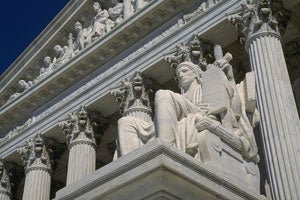Justin Raphael ’09 and Andrew Furlow ’09 both had gained litigation experience during their summer law firm work. But sitting in the U.S. Supreme Court on March 30, watching constitutional scholar Samuel Issacharoff present an oral argument they’d helped research and prepare, they gained an entirely new appreciation of the process.
Issacharoff, a professor of at New York University School of Law, was a visiting professor at HLS during the fall ’08 semester when he asked the two students to help him represent the plaintiffs in a complicated case involving asbestos litigation and bankruptcy court. Furlow recalls that when Issacharoff approached him about working on the case, he replied: “Do you have to ask?”
Travelers Indemnity v. Bailey and the consolidated case Common Law Settlement Counsel v. Bailey stem from the 1986 settlement between the bankrupt Johns-Manville Corp. and 660,000 claimants injured by exposure to asbestos. As part of the $2.8 billion settlement, insurers received immunity from future related claims.
But plaintiffs lawyers later found other grounds to sue insurers including Travelers, and the company eventually agreed to fund a $500 million trust for new plaintiffs, in return for immunity from further claims. When other plaintiffs not part of the new settlement objected, the U.S. Court of Appeals for the 2nd Circuit agreed, finding that the bankruptcy court did not have the power to immunize Travelers from the other claims. The Supreme Court granted review.
Harvard law played a role on both sides of the case, with professor and bankruptcy expert Elizabeth Warren assisting in the representation of Travelers Indemnity. “The Supreme Court was called on to rule whether the bankruptcy court had overstepped its jurisdiction with respect to the company’s insurance proceeds,” she says. “I believe that when the founders included bankruptcy in the Constitution that they envisioned a bankruptcy system that is flexible and that has the kind of broad reach that was used in this case.”
Furlow says he was delighted at how extensively he and Raphael were included in the process, which also involved other attorneys and NYU law students. From discussions of case strategies to proofing the brief to attending the moot at Georgetown the week before the arguments, “for much of the high points of a Supreme Court case, [we were] there,” says Furlow. “Pretty amazing.”
Raphael says the experience assisting in the drafting and editing of the merits brief and the brainstorming with Issacharoff and other attorneys was invaluable. “I saw first-hand how what seem like the most obscure fact … or the most arcane legal doctrine can turn a plausible argument into a strong one.” That made him appreciate “as never before how well and how broadly a lawyer has to know the facts of his case or the law that applies to it in order to find that nugget that can ultimately make the difference. They tell you that on the first day of Legal Research and Writing, but having the opportunity to work on an argument from beginning to end in this case really brought it home.”
On the day of the arguments at the Court, Furlow was surprised at how full the gallery was. For the uninitiated, he says, it didn’t seem like the most accessible subject matter. “But we were hanging on every word. We came out of the Court talking like we’d seen it a hundred times: ‘Man, Ginsburg wouldn’t let him off the hook!’ ’Did you notice how quiet Scalia was?’ But I think we were just excited to be there in the Supreme Court, listening to their questions, and knowing that we knew most of the answers.”
Raphael agrees. “It was beyond gratifying to hear the justices ask questions that really engaged with the arguments that we had parsed back and forth a thousand times. Not only did it make all of that work seem worth it and then some, but it gave me enormous confidence that I really did pick the right career.” He will start work in the fall as an associate at Paul, Weiss, Rifkind, Wharton & Garrison in New York. Furlow will clerk for Judge David Hamilton of the Southern District of Indiana and has taken an offer to start at Hogan & Hartson in Washington, D.C., in the fall of 2010.
The Court’s decision in the case is expected later this month.
